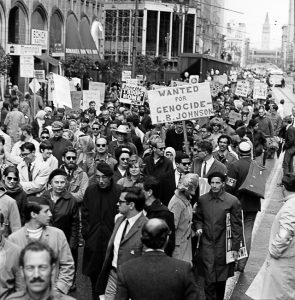
April 15, 1967, San Francisco, CA. The march turned up Fulton Street and continued to Kezar Stadium in Golden Gate Park. Source: Harvey Richards Media Archive.
On April 15, 1967, amidst growing opposition to the U.S. war in Vietnam, large-scale anti-war protests were held in New York, San Francisco, and many other cities.
In New York, the protest began in Central Park, where more 150 draft cards were burned, and concluded at the United Nations with speeches by Reverend Martin Luther King Jr. and others.
Activist photographer Harvey Richards documented the San Francisco march which was so large that the crowd filled the Kezar Stadium. (See photos below and more here.)
One of our teacher colleagues, Kipp Dawson, was an organizer of the march and on the stage shown in the third photo. Read her memories of that day below.
Kipp Dawson, Pittsburgh middle school teacher and lifelong social justice activist, wrote to tell us,
Thank you for sending the collection of photos by Harvey Richards. They brought back many memories of the anti-war mobilization on April 15, 1967, where I was helping to greet speakers and arrange the stage. I was the “executive director” of that action on the west coast, working with Dave Dellinger, James Bevel (whom Martin Luther King’s organization had sent to help us organize once King had agreed to participate, and as King was preparing for that historic “Beyond Vietnam” speech), along with many, many others. That day was a turning point for the anti-war movement — our first big demonstrations. King’s support certainly was pivotal. The movement had been growing quickly and strongly since the 1965 teach-ins against the war. But none of us, on either coast, had any idea how huge the turnout would be that day.

April 15, 1967, San Francisco, CA. Arriving at Kezar, the protesters filled up the entire Stadium. Source: Harvey Richards Media Archive.
I opened the rally, speaking into a mike from the center of that stadium. In addition to welcoming the huge assembly, I focused my brief remarks on saluting the then-nascent anti-war movement developing among active-duty GIs — to which the football stadium-filled crowd responded with a mighty roar that I can still hear. On that stage, I sat somewhere between Coretta Scott King and Judy Collins, one of the first singers to publicly oppose the war.
The media coverage was quite horrible. In fact, in a front page article in the Sunday San Francisco Examiner the week before the march, Joan Baez was quoted calling on people not to go the march, as it was not a real peace demonstration, but a cover for communist support of the Viet Cong. I was mentioned as proof, since I (21 at the time) was a member of the Socialist Workers Party. (In my opinion, Joan Baez has done so much to more than make up for that mistake she made back then. She’s one of my favorite singer-songwriters now, as she had been before that error.)

April 15, 1967, San Francisco, CA. The march started at the foot of Market Street. Source: Harvey Richards Media Archive.
I just came across this transcript of HUAC hearings in 1968 (the government’s infamous McCarthyite House Committee on Un-American Activities). My sister youth activist Tracy Sims and I (and my mom Ann Dawson) are mentioned here along with lots of others, including many arrested in the San Francisco civil rights demonstrations, naming us as children of Communists (which some of us were). As the huge turnout for the April 15, 1967, demonstrations illustrated, our movement was on the upswing, but still being harassed in a witch-hunt — a desperate attempt to stop the history we were making across this country and around the world.
Today, when the latest brood of anti-human scum attempt to intimidate and block the young justice fighters, it is important that they know about the previous generations who also prevailed over ignorance and fear — just as my generation took courage from those in whose footsteps we followed. The Standing Rock/Water is Life and Black Lives Matter leaders show us the strength we can get from those whose battles paved the way for us over generations and centuries. We are the history and the future. We need to know the past as we build for the future, both of which are grounded in a vision which feeds us and binds us together, and makes our lives rich.
The Zinn Education Project offers resources for teaching outside the textbook about the opposition to the Vietnam War, including Dr. King’s speech at Riverside Church earlier that month.











Twitter
Google plus
LinkedIn